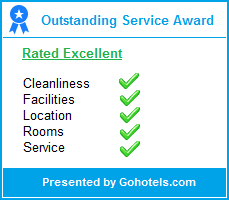Fishing Equipment
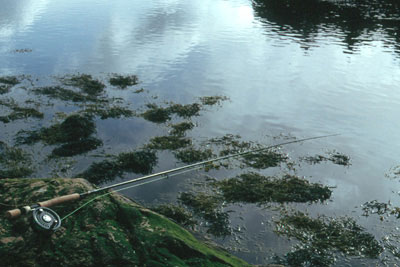 Written by Hans van Klinken
Written by Hans van Klinken
Fly Rods
For Atlantic salmon fishing I personally prefer a single handed rod for most locations and conditions. Only in really big rivers, like the lower Humber, for example, I would use a double hand rod, but mainly for experiments because I simply don’t like to play a fish with such a big and powerful rod. I also like a rod with a stiffer tip, so that I can use the rods in saltwater, estuaries and with sinktip lines as well. A good salmon fly rod usually start at #7 line weight and go all the way up to the 10/11 weight. Although I have landed many grilse with #6 weight rods, I still advise other people to take a weight #7 or #8 rod, just because it’s better for the fish when you release it again. I play rather quickly and powerfully, but many people play too softly, and it will take ages to land a grilse with a light rod. If you play it too long, there is a big chance that the fish will not survive anyway! The action of the rod I would prefer is medium-fast and fast, just to be sure to be able to cast in the windiest of conditions. Rod lengths from nine and nine and a half feet will do perfectly for most fishing techniques but some people like to use a eight or eight and half feet when the river is quite small. I always take at least one spare rod per person. Personally I use a weight #6 rod for brook trout and grilse in small rivers.
Reels
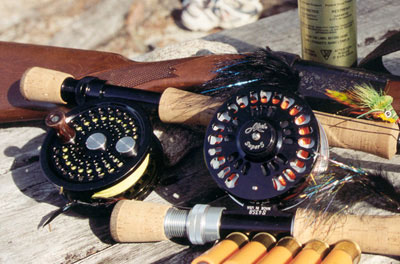 For many people, a fly fishing reel is an extremely important item among their fly fishing equipment. Other fly fishers see a reel as a line holder only, and I must confess that I never had any high priorities for reels until I started to fish for salmon and sea trout more frequently. Actually the reel became very important to me when I ran into the bigger fish! While years passed quickly, I discovered how to catch salmon and sea trout in the beautiful estuaries of Norway, and there I noticed that saltwater had an enormous impact on my reels. In spite of cleaning them quite often, I could not protect them against the bad influence of the salt. The reels that I owned in my early days were simple, and not built for saltwater, and therefore most of them didn't last long. When I gained more and more experience, and the fish became a lot bigger too, the need for an excellent drag system became more important as well. I was lost for quite some time in my search for the perfect reel that fit me the best, and because there were so many different reels available, it was really hard to make a quick choice. This is why I started to do some very serious testing with reels. I can imagine that the nowadays fly fisher has similar problems. It is not easy to find a good reel, and prices for excellent reels are high, which surely has an enormous influence on a fly fisher's decision or choice. After more then 30 years of fly fishing experiences, I learned a lot of things, and in spite of the fact that I started with rather cheap materials and equipment as most of us did, I quickly realized that good quality has a high price too. All hobbies are expensive, and the more serious people are into their hobby, the more money they are willing to spend.
For many people, a fly fishing reel is an extremely important item among their fly fishing equipment. Other fly fishers see a reel as a line holder only, and I must confess that I never had any high priorities for reels until I started to fish for salmon and sea trout more frequently. Actually the reel became very important to me when I ran into the bigger fish! While years passed quickly, I discovered how to catch salmon and sea trout in the beautiful estuaries of Norway, and there I noticed that saltwater had an enormous impact on my reels. In spite of cleaning them quite often, I could not protect them against the bad influence of the salt. The reels that I owned in my early days were simple, and not built for saltwater, and therefore most of them didn't last long. When I gained more and more experience, and the fish became a lot bigger too, the need for an excellent drag system became more important as well. I was lost for quite some time in my search for the perfect reel that fit me the best, and because there were so many different reels available, it was really hard to make a quick choice. This is why I started to do some very serious testing with reels. I can imagine that the nowadays fly fisher has similar problems. It is not easy to find a good reel, and prices for excellent reels are high, which surely has an enormous influence on a fly fisher's decision or choice. After more then 30 years of fly fishing experiences, I learned a lot of things, and in spite of the fact that I started with rather cheap materials and equipment as most of us did, I quickly realized that good quality has a high price too. All hobbies are expensive, and the more serious people are into their hobby, the more money they are willing to spend.
After many years I finally started to realize what I really wanted. The reel I was looking for must have an excellent and perfectly adjustable drag system. During all the tests I did, I quickly discovered that cork is still one of the best materials to use for the drag system, because cork is able to compress well but always will return to its original shape again. Many reel manufactures have replaced cork for synthetics or composites, and some of those reels indeed work quite well, but not as perfectly as with cork. At least that has been my personal impression over the years. The biggest problem with cork is that not all manufacturers using high quality cork, and when that happens, you create bad stories easily. If you use cork, you have to use the best of the best.
I prefer a reel with a large backing capacity, and to reduce price a bit, I became quite enthusiastic about interchangeable spools. I don't mean spare spools, but spools that can fit on different types of reels. For my special way of fishing, I wanted a large abor reel because it lays the line in much larger coils on your spool which will not only reduce reel memory in the line, but also prevents kinking and twisting. There are even more benefits because it will also makes the retrieving a lot faster, because you gain much more line by each turn of the handle.
Fishing Flies
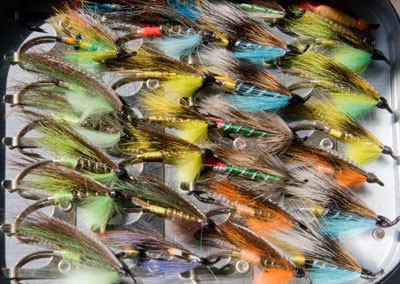 I always keep to the rules, and when the rules are telling me not to use weight in the flies, I don’t, and even tie my nymphs without any lead at all. For salmon fishing I use dry flies, wet flies and even unweighted nymphs. For trout and estuary fishing I also use streamers, bugs and terrestrials. I mostly chose flies feelingly and when everybody using a Blue Charm, I absolutely will tie on a complete different one! Most of the time I use my own patters, such as special surface skaters and wakers and of course the Bondal Series!.
I always keep to the rules, and when the rules are telling me not to use weight in the flies, I don’t, and even tie my nymphs without any lead at all. For salmon fishing I use dry flies, wet flies and even unweighted nymphs. For trout and estuary fishing I also use streamers, bugs and terrestrials. I mostly chose flies feelingly and when everybody using a Blue Charm, I absolutely will tie on a complete different one! Most of the time I use my own patters, such as special surface skaters and wakers and of course the Bondal Series!.
The flies with most power are those who you belief in the most but neve runderestimate the help from a good and reliable guide too. They usual know the best which flies will do the damage!
Fly Lines
I mainly use floating lines in Newfoundland but there is one exception. When I fish coastal waters and estuaries I discovered that a 100-175 grain sinktip line can be extremely powerful and seems to work a lot better in windy conditions as well. So far I succeed best with light sinktip lines above a floater in coastal waters.
Leaders
I only use my own made intermediate braided leaders and leader system for private use and workshops and classes as well, so I have no experiences with other leaders or leader materials.
What To Put In Your Fishing Vest Or Pack
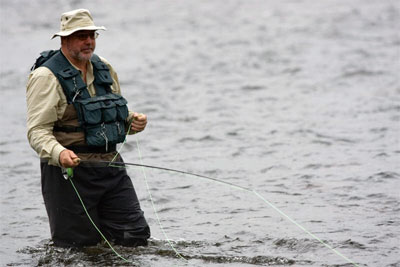 • Forceps or multi-tool: Used to squeeze the barb of my fly hooks closed, which makes it possible to unhook a fish much more easily at times when they took the fly a little deeper than expected. I use forceps with the claw mouth in a 45% angle.
• Forceps or multi-tool: Used to squeeze the barb of my fly hooks closed, which makes it possible to unhook a fish much more easily at times when they took the fly a little deeper than expected. I use forceps with the claw mouth in a 45% angle.
• Good quality clipper: To save my teeth and cut nylon.
• Retractors: Usually the forceps and clippers will be connected to a retractor. The retractor is just an awesome device and makes locating and using your tools much easier and quicker.
• Hook sharpener: I always have two hook sharpeners with me. One for small hooks, and the other one for larger hooks. Wherever you fish with stones and pebbles around, you will need them.
• Fly pad: I use mostly 2 self-made fly-pads, one on each top pocket, and replace them every year. I use them to dry my flies.
• Pocket lamp: I always have a small waterproof MagLite with me. It can be very helpful when I fish longer then expected. It's quite handy when you still have a long and dark forest hike remaining before reaching your accommodations or car.
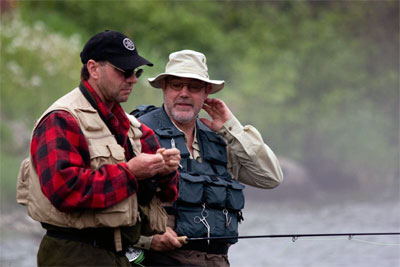 • Whistle: A highly underestimated attribute. I added this to my vest after I heard a story about a man who broke his leg while fly fishing, and ran out of voice while shouting for help. The whistle saved his life.
• Whistle: A highly underestimated attribute. I added this to my vest after I heard a story about a man who broke his leg while fly fishing, and ran out of voice while shouting for help. The whistle saved his life.
• Matches / Lighter: I always have some matches or a lighter with me. I put them in a tiny waterproof bag. They have often helped me out after I slipped in the water, and used them to make a big campfire to dry my stuff. (Oh do not tell me you never fall in!!)<br/ > • Tippet material: Depends on the type of fishing, but on my holidays I usually have six spools of different size tippet material with me. Three spools for salmon fishing and three spools for trout. For real big salmon I use strengths of 10lbs, for rivers where I can hook salmon or grilse I use 8lbs, and for rivers with grilse only I use 6lbs. For all my salmon fishing, I use exclusively Maxima. For trout, I mainly use tippet material in strength between 2 and 4lbs.
• Leader wallet contents: Spare leaders, a few special needles to make my own leaders, waterproof Super Glue to secure my leader on my fly line, a small scissor, a little bobbin with thread, and some braided monofilament and backing for attaching my leader to my fly line, and for emergency repairs on a fly line. In the wilderness, I often have used my Super Glue as a perfect replacement for plasters, and also during serious first aid situations as well. In many circumstances, it works perfectly when you have cut your skin, and it actually needs to be stitched. (Imagine you are at a fly-in lodge.)
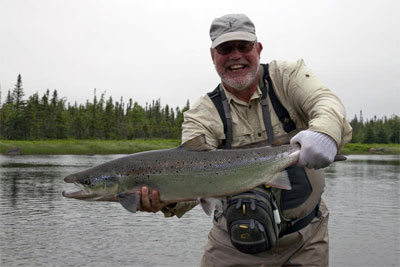 • Fly boxes: I have several boxes with nymphs, dry flies and other required patterns for the type of fish I am after that day.
• Fly boxes: I have several boxes with nymphs, dry flies and other required patterns for the type of fish I am after that day.
• Floatant: To use on my dry flies to keep them floating longer.
• Bug Spray & Bug Net: are essential in buggy areas or Mosquito Heaven.
• Measuring tape: Required to measure a good size fish so you are sure that you don't make a fool of yourself.
• Diary or Notebook: I keep it with a pencil in a little waterproof bag to make essential notes about insects, hatches, weather conditions, water temperatures, air temperatures, fish behaviour, and when I change a certain fly pattern, or just in case I suddenly get any good idea.
• Leader stretcher: I don't use one. I prefer to tie on a new tippet instead.
• Fly line cleaner patch (very tiny): To clean and protect my floating lines from sinking.
• Thermometer: I have one with me to complete important notes in my diary.
• Small Pocket Camera: For a lucky shot or nice fish.
• Polaroid Glasses: Indispensable when sunny.
• Knife: Very handy for all kinds of things and making a fire as well.
• Retrieving protection: Essential when fishing techniques requires a lot of fly action below the surface. It will protect my fingers while stripping or retrieving.
• Special Glove: To tail slippery fish, I take this with me when I fish for slippery fish species. Very handy to tail salmon as well.
• License: Indispensable, we don't want to fish illegally!
• Toilet paper: You never know.
• Rain Jacket: Will be in the back of my vest.
• Inflatable Life Jacket: I personally don't use it, but I always recommend one to everybody else in my workshops and classes, just for safety reasons.
Article written by Hans van Klinken
All Photos by Hans van Klinken

